
They lay where they fell, backs or bellies against the concrete, wings perfectly tucked, as though the work of a roving taxidermist.

Photo Credit: Andrew Harmon
In lower Manhattan this past weekend, I ran into four within 10 minutes. An American Goldfinch surrounded by cigarette butts at the corner of Wall Street and South. A juvenile American Robin lying supine near Hanover Square. A few blocks north, two White-throated Sparrows -- at the foot of my own apartment building.
Hear the term "bird strike" and you may think of Canada Geese flocks sucked into jet engines, causing such scenes as the emergency landing of U.S. Airways Flight 1549 into the Hudson River nearly four years ago. But there's another type of bird strike happening this season across the country, one that any early morning jogger setting out in New York and other cities likely has seen.
Birds can smash into windows at any time of day. Light pollution at night seems to compound the problem: Weary migrating birds can fall victim to the "beacon effect" of illuminated tall buildings, becoming disoriented, especially during poor weather. Though researchers haveyet to conclude what causes this attraction to artificial light, what can happen as a result is despairing: finches, robins, sparrows, and other migrants crash into the facades, or circle structures until they fall to the ground from exhaustion. These birds are often snatched by other animals or swept up by cleaning crews before many of us hit the pavement for work in the morning.
Visit the Fatal Light Awareness Program's website, and it keeps a running tally on the approximate number of birds killed in window crashes since you arrived at the homepage. The number reaches into the thousands within seconds. In New York, located on one of four primary migration routes in North America, Audubon estimates that 90,000 birds die each year from flying into buildings and other structures.
Bird-friendly designs that cut down on the amount or use of reflective glass are on the rise, and hopefully will some day become standard. Other solutions have more to do with energy consumption than design. For instance, in peak fall migration season, many New York skyscrapers participate in the Lights Out NY Program, currently in full swing through November 1, where participants agree to shut off lights from midnight to dawn.
Perhaps it's easy to roll one's eyes at such efforts, what with myriad macro-environmental issues facing this planet. To do so is to overlook the remarkable power of birds to connect us with nature, and, as Carl Safina wrote in his 2002 masterpiece Eye of the Albatross, possibly to our own buried dreams: "Beneath the daily overburden, our truer nature is this wandering spirit on expansive wings, hungering for a chance to search new horizons, to hurtle along with the wind, taking chances, taking the world as it comes, making tracks that will endure only in our memory, forming our personal map of life and time."
My apartment building, a high-rise hurdle on a great migratory path that far precedes this city's existence, is currently not a participant in Lights Out (I'm working on that). What about yours?